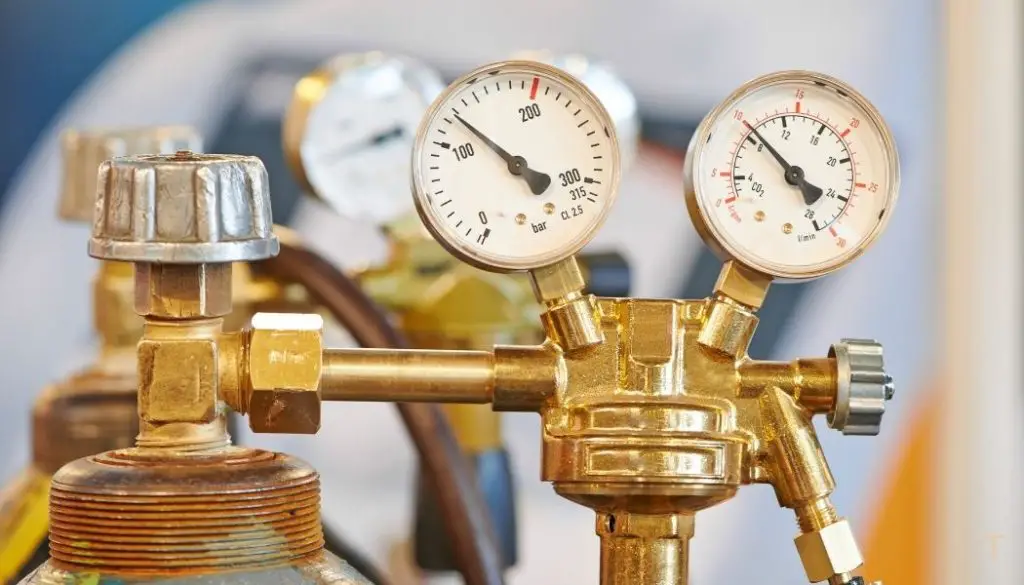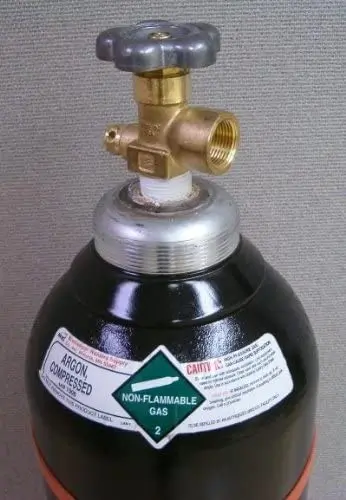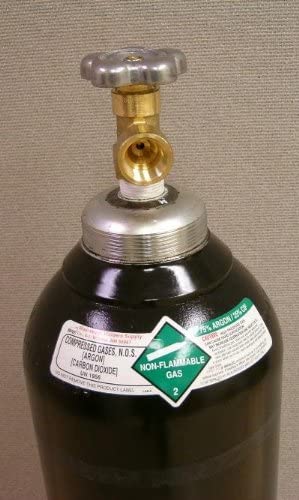For MIG welding, use a shielding gas that suits your material. Common options are: 100% Argon for aluminum, a 75% Argon/25% Carbon Dioxide mix for mild steel, and a 90% Argon/10% Carbon Dioxide mix for stainless steel. Choose the appropriate gas for optimal weld quality and appearance.
It is important to know what gas to use for MIG welding because it will ensure proper performance and productivity. Choosing your gas is almost as important as choosing the right MIG welder.
When choosing the correct shielding gas for MIG welding, various aspects should be considered, including the type of metal to be welded, the thickness of the metal, time constraints (for example, indoors versus outside), and personal choice.

| Shielding Gas | Argon | Carbon Dioxide | Helium | Oxygen |
| Purpose | Most Widely Used – Suited for Thin Material | Purest form of MIG Welding | Best for Aluminum | Suited for Stainless Steel |
| Features | Reduces Spatter | Penetrates Deeply | Most Expensive | Prevents Weld from Burning |
| Preview |  |  |  |  |
| Volume | 125 cu/ft | 125 cu/ft | 40 cu/ft | 80 cu/ft |
| More Info | Check Latest Price | Check Latest Price | Check Latest Price | Check Latest Price |
Table of Contents
Different Shielding gases available for MIG welding
Sometimes can get confusing knowing which one to use So let’s try and understand the different types of shielding gases available for MIG welding.
Argon (Ar)
Argon is one of the most widely used shielding gases for MIG welding. It is inexpensive and readily available. It has the lowest thermal conductivity of all shielding gases, which helps keep heat in the weld area. It is recommended for welding on thin material as it reduces spatter.
However, adding other gases such as Helium, will improve the penetration and can be used for welding thick materials.
Carbon Dioxide (CO2)
Carbon Dioxide can be used in its purest form for MIG welding, but in a lot of cases people are mixing it with and Argon to achieve better arc stability.
Carbon dioxide is the cheapest MIG welding shielding gas. It also penetrates thick materials and deep welds effectively. When used alone, the arc will not be very stable and produce much spatter.
Helium (HE)
Helium is the best shielding gas for aluminum. It protects aluminum welds from oxidation and it is highly recommended that you use helium with argon. When used with 75% argon and 25% helium, aluminum filler metal will flow evenly with less risk of burning.
With the use of Helium, you can achieve deep penetration so it works well with thick materials.
The downside of using helium is the price. It is not easily available and it is very expensive. It is hard to get pure Helium, even at welding supply shops, where you will mostly find mixtures of helium-argon gases.
Oxygen (O2)
Oxygen is mainly use used to improve the weld quality by preventing weld metal from burning and decreasing the heat input. Welders mostly use it on stainless steel.
It is easily available and it does not cost as much as Helium. However, it is not recommended for aluminum and copper, because it can lead to porosity and cracking of welds.
How to choose the right gas for MIG welding?
Several factors should be considered in choosing the right gas, such as the kind of metal that needs to be welded, the thickness of the metal, time limit restriction (for instance, indoors versus outdoors), and personal preference.
Here are some factors to consider:
1) What kind of metal needs to be welded?
First, it is important to know what kind of metal needs to be welded. This will determine the shielding gas that should be used.
- Aluminium – Argon and helium
- Stainless steel – Oxygene and Argon mostly
- Copper – Argon or argon and Helium
- Chromium and Nickel – Argon or Argon with Helium
- Iron – Argon mostly. You can add Helium to increase penetration.
- Cobalt – Argon and helium
2) How thick is the metal?
The thickness of the metal will determine the best shielding gas to use. For example, if you are welding steel which is thicker than 10 mm, it is best to use Argon or argon with Helium to provide deep penetration.
3) How long is the time limit?
If you are welding outdoors, you should consider the time limit restriction. For instance, if you are working for 1 hour or more in open air, it will be best to use argon instead of CO2 because CO2 can cause wind burn.
4) Personal preference
There are welding projects where you can choose your metal filler and shielding gas based on your preference. For example, if you are welding iron, you can choose mix of argon and helium or pure argon.
5) Will the project is limited by the amount of time?
If you are doing welding that is limited by time (in other words, how long it takes to complete one pass), you can use systems that can easily mix gases. If you do not, it will be difficult to change the shielding gas when needed because it is time-consuming and costly.
6) Will the project provide you with several times to weld?
If your welding projects will allow you to do it over and over again, you can also buy expensive welding machines that feature gas solenoid valves. This will allow you to switch between different gases at any time and it is very practical.
Your welding machine should have a regulator and flow meter so you can easily control the shielding gas flow and get accurate measurements.
7) What welding position will be used?
Another thing to consider when welding a metal is your welding position. If you will be using the flat or horizontal welding position, you will need to use a gas that is heavier than air. This will prevent bowing of the puddle due to wind. Argon is a good choice for this situation.
If you will be using the vertical welding position, it will be best to use a gas that is lighter than air so it will not affect the control of your puddle. Helium can be used for this purpose because it is less dense that air and it will not affect the puddle.
8) How old is your welding machine?
If your welder is more than 10 years old, you might need to replace some parts. If this is the case, it will be best to use argon instead of helium because many welding machines could not handle helium. Argon is also a good choice if you need to weld nickel alloys because it can reduce the amount of dross.
9) Will you do multiple passes?
If you are welding multiple passes, it will be best to use argon instead of helium because helium is more expensive. Argon can provide excellent protection against oxidation and it can also be used for welding of nickel alloys.
10) Will you need to work on stainless steel or aluminium?
If you are working on stainless steel or aluminium, it will be best to use argon because helium may cause micro-pitting and porosity. Argon can also help your welding project requires a lot of precision.
What does shielding gas do?
The job of the shielding gas is therefore to protect the molten puddle from oxygen in the air by pushing it away via convection currents.
Oxygen will cause the weld puddle to become unstable, causing an inconsistent weld. Also, oxygen has a level of energy close to the molten puddle’s temperature. This means that even though you may remove it by pushing it off with shielding gas , it will still come back to the molten puddle.
This is dangerous because the oxygen bubbles will interfere with the weld current, increasing spatter and causing porosity .
You do not want any of the above to happen so it will be best to use an appropriate shielding gas instead.
What is the difference between argon and helium?
Argon and helium are both non-reactive gases. This means that they do not react with other elements at high temperatures, making them ideal for welding. Let’s name some differences between them:
- Helium has a lower density compared to argon so it will float above the molten puddle. Argon is denser than air, which means that it will be pulled downwards by gravity and flow around the metal.
- Argon covers a wider range of temperatures because its boiling point is -186 degrees Celsius while helium’s boiling point is 4 K.
- Argon can also cover a wider range of amperage because its thermal conductivity is twice as high as helium.
- You can use Argon in situations where you have to do multiple passes, work on nickel alloys and stainless steel. It is also good at preventing oxidation. Helium, on the other hand, can be used in situations where you will need to do single pass, work on copper and aluminium. It is also good for increasing penetration speed.
What is the difference between argon and CO2?
There are many differences between argon and CO2.
- Argon is a noble gas that does not react with other elements at high temperatures. It is also non-toxic and non-corrosive, making it ideal as a shielding gas. Argon has several uses such as in purging, blanketing and welding . On the other hand, CO2 is a chemical compound that can be toxic so it is not used in many situations.
- CO2 has different advantages compared to argon such as the fact that its thermal conductivity is higher than argon but lower than helium.
- It is also known for increasing penetration speed and improving arc starts. There are also times when you will need to use a mixture of argon and CO2 because it can be used for welding steels that have rust or mill scale.
- Argon is better than CO2 because it can maintain a more stable welding arc.
What is a good gas mix for MIG welding on aluminum?
Aluminum has a low melting point so using pure argon as your shielding gas can be risky. It will react with pure argon which will create a slag that is very difficult to remove so It’s best to use mixture.
Having the right mixture of argon and helium (most common 75% argon and 25% Helium) for your MIG welding project will save you from additional future expenses because you won’t have to replace parts due to corrosion.
Adding helium will help increase the penetration speed and leave a cleaner weld. Helium is also known to reduce weld porosity that can affect appearance.
Aluminum tends to be more difficult to weld because it has high thermal conductivity, high heat variation during welding and form stiffness which make it harder for heat to dissipate.
NOTE: MIG welding is one of the easiest welding methods that you can learn. It does not require too much effort, making it perfect for beginners. Having the right equipment at home can be very expensive so knowing how to use your MIG welder properly is crucial.
Can you MIG weld without shielding gas?
Yes, you can MIG weld without using a shielding gas. However, you can’t expect clean, high-quality welds. There will be a lot of spatter and oxidization on the puddle from atmospheric oxygen, which can cause porosity in your weld so cracks might develop along with the bead.
It is also possible that the weld pool will become more fluid, resulting in inconsistent penetration. You would need to perform frequent passes for this type of welding process to work properly.
Related Questions
How to use helium for MIG welding?
You can use helium by installing a hose that is compatible with it. Be sure to set the flow regulator at 15-25 litres per minute, or 1 cubic foot per hour to prevent damage.
To make sure that you are using the right gas mixture, read your welding machine’s manual before starting your project.
How to use argon for MIG welding?
First, choose your MIG welding machine. Argon is usually stored as a liquid so you will need to use a high wattage welder that has the capacity to heat up the gas.
Installing a hose that is compatible with argon will do the trick. Be sure to set the flow regulator at 15-25 litres per minute, or 1 cubic foot per hour to prevent damage.
To make sure that you are using the right gas mixture, read your welding machine’s manual before starting your project.
How to use CO2 for MIG welding?
In order to use CO2 for your MIG welding project, you will need a high-strength 100 amp or above welding machine. You will also need to install hoses that can handle the pressure of this gas. Be sure to set the flow regulator at 15-25 liters per minute, or 1 cubic foot per hour to prevent damage.
To make sure that you are using the right gas mixture, read your welding machine’s manual before starting your project.
Related Posts
- 8 Tips for MIG Welding Beginners
- MIG vs TIG Welding
- MIG welding – Gas or Flux Core?
- Lincoln Electric Pro MIG 180 Product Review
- Welding Helmets for the Beginners
- Beginner Projects for New Welders
- Beginner tips when starting to weld
- What is Cold Welding?
- Difference between Spot and MIG Welding
- How To Choose Between 030 and .035 Flux Core Wire?
- What are MIG Welding Advantages And Disadvantages
